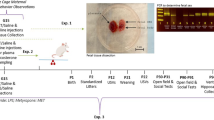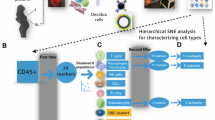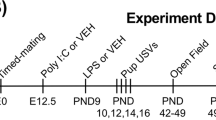Abstract
The effects of cocaine are well documented in the CNS; however, recent evidence suggests that cocaine may suppress the immune system. Maternal cocaine use essentially exposes the fetus to a continuous exposure of cocaine. The objective of this study was to investigate the immunomodulatory effects of cocaine and its metabolites on maternal and fetal immune systems. Subjects were recruited from an Investigational Review Board approved protocol, and biologic specimens were collected. For each subject peripheral blood mononuclear cells (PBMCs) were isolated by density gradient. Each PBMC sample was stimulated in separate wells with phytohemagglutinin and phrobol 12-myristate 13-acetate. Samples were radiolabeled and stimulation was measured. Cytokine measurements were made on the serum via ELISA assay techniques. In both the phorbol 12-myrisate 13-acetate and the phytohemagglutinin group, the PBMCs isolated from fetal cord blood in the cocaine-using group had significantly (p < 0.05) decreased responses compared with control subjects. IL 1 and IL 2 concentrations were suppressed in the cocaine-exposed fetal serum compared with controls(p < 0.005 and p < 0.05, respectively). We have shown that in utero cocaine exposure results in a nonspecific suppression of fetal T lymphocyte response. The clinical consequences of prenatal cocaine-induced immunosuppression need to be further explored.
Similar content being viewed by others
Main
Cocaine is a major drug of abuse that has increased in popularity over the last decade(1). The effects of cocaine on the CNS are well characterized and demonstrate a biphasic pattern of intense stimulation followed by depression. Cocaine toxicity has been the target of extensive research in recent years and has been associated with respiratory collapse, generalized seizures, arrhythmias, and subarachnoid hemorrhage(2–8). Recently, cocaine has been identified as possessing immunomodulatory properties, including T lymphocyte suppression and alterations in immunoglobulin production(9,10). In general, studies suggest that the immune system requires a continuous exposure to cocaine to express its stimulating or suppressive effects. Maternal cocaine use during pregnancy exposes the fetus to prolonged exposure to the drug because the fetus lacks the metabolic and excretory capacity of adults. Thus, the fetus in a cocaine-using mother may be continually exposed to cocaine and/or its metabolites during pregnancy(9). The objective of this study was to investigate the effects of cocaine and its metabolites on the maternal and fetal immune systems through in vitro analyses of their respective lymphocytes.
METHODS
Subjects. Control and study subjects were recruited from an Investigational Review Board approved protocol. Experienced interviewers evaluated potential subjects before delivery. Cocaine users were identified through a previous history of cocaine use documented in the medical record. The target population was defined as any subject possessing a positive finding of cocaine or a metabolite (norcocaine, benzoylecgonine) in any of the biologic samples taken, which included maternal hair, maternal serum, amniotic fluid, fetal cord serum, infant urine, and meconium. Biologic samples were analyzed for cocaine through HPLC. Patients were also identified as users if a women admitted use regardless of biologic sample analysis results. Control subjects were recruited immediately after the enrollment of a cocaine user in the study. These control subjects were adult pregnant women. Interviewers determined extensive patient histories including frequency and amount of cocaine, nicotine, marijuana, and alcohol use. Additional information on nutritional status and socioeconomic status were also obtained by the interviewers.
Isolation of PBMCs. For each study and control subject enrolled in the study, 20 mL of cord blood and 20 mL of maternal peripheral blood were collected in heparinized green top tubes for the isolation of PBMCs. Each sample was divided into two 10-mL aliquots and transferred into 50-mL conical tubes. Each tube was diluted to a volume of 40 mL with Hanks' balanced salt solution and vortexed for 1 min. Each tube was then underlaid with 10 mL of Ficoll Hypaque density gradient. The tubes were centrifuged for 30 min at 1200 rpm.
After centrifugation, the interface cell layer was removed from each tube, and the cells from each corresponding pair were pooled into one 50-mL conical tube. Each new aliquot was brought to a volume of 50 mL with Hanks' balanced salt solution. The tube was centrifuged for 10 min at 1200 rpm. The supernatant was decanted off, leaving 1 mL above the cell pellet. The pellet was resuspended and vortexed. The cells were counted using a Neubauer counting chamber and viewed under a microscope at 40× magnification. The viability was assessed during counting via a trypan blue exclusion stain. The cell volume was adjusted with tissue culture RPMI medium containing 30% HSA to achieve a concentration of 4 × 106 cells/mL. A 1-mL aliquot was removed and brought to a volume of 4 mL with RPMI, achieving a new concentration of 1 × 106 cells/mL. This aliquot was used for proliferation assessment. The remainder of the cells were frozen with 10% DMSO in 1-mL aliquots at -70°C. After 24 h the cells were transferred to a -180°C cryogenic freezer.
Cell proliferation assay. Proliferation ability was measured by using a cell solution at a concentration of 1 × 106 cells/mL. The 4-mL aliquot was divided into a 2-mL portion and two 1-mL portions. PHA was added at a concentration of 5 µg/mL to a 1-mL aliquot. PMA was added at a concentration of 80 ng/mL to the other 1-mL aliquot. Control samples included unstimulated cells and tissue culture medium. One hundred microliters of the cell solutions were placed into their corresponding wells of a 96-well microtiter plate with an equal amount of RPMI with 5% HSA. Each of the test wells were repeated in triplicate. A culture medium control consisting of 200 µL of RPMI with 5% HSA was also assayed. The microtiter plate was covered and incubated at 37°C with 5% CO2 for 48 h. Each well was then radiolabeled with 10 mCi of[3H]thymidine and incubated for an additional 24 h at 37°C. The radiolabeled cells were then harvested on filtermat paper using an automated cell harvester. Once the filters were completely dry they were transferred to 7-mL polypropylene scintillation vials. Three milliliters of Ecoscint-O brand scintillation mixture were added to each vial. Each sample was then read on a scintillation counter to assess the presence of [3H]thymidine incorporation by the cells and reported in counts/min.
Serum collection and storage. Seven milliliters of cord blood and 7 mL of maternal peripheral blood were collected from each study subject in red top vacutainer tubes. Each tube was allowed to clot and then centrifuged at 1200 rpm for 10 min. The serum was pipetted off and stored in 0.5-mL aliquots in 1-mL cryovials at -200°C for cytokine analysis.
Cytokine analysis. The samples were evaluated as either being controls or targets. Five samples were selected from each maternal and fetal group (control and target) to be evaluated for IL-1, IL-2, IL-4, and interferon-γ. Due to the low blood volumes collected for immunologic assays, there were few samples with enough serum for cytokine analysis. The levels of each cytokine were quantitated via an ELISA technique using Quantikine kits by R&D Systems (Minneapolis, MN).
Statistical analysis. All data were evaluated in the nonparametric statistical analysis of Wilcoxonian test.
RESULTS
A total of 91 patients were enrolled. The cocaine-using group contained 42 patients, and the control group contained 49 patients. In both the PMA and the PHA group, the lymphocytes isolated from fetal cord blood in the cocaine-using group had significantly (p < 0.005) decreased responses compared with control subjects (PHA 95430 ± 9786 control versus 73763 ± 7074 target, PMA 19986 ± 1778 control versus 16690 ± 2087 target) (Figs. 1 and 2). Unstimulated cells had counts less than 1000 cpm in all samples, and tissue culture control samples were less than 200 cpm. There was no statistical difference in maternal lymphocyte responses between cocaine users and control subjects from any test.
Cytokine concentrations parallel the results seen in the mitogen stimulation experiments. IL-1 and IL-2 concentrations were suppressed in the cocaine-exposed fetal serum compared with that of control subjects [IL-1(pg/mL), 7.425 ± 0.4311 control versus 6.332 ± 0.2370 target; IL-2 (pg/mL), 53.06 ± 1.55 control versus 49.63 ± 0.549 target] (p < 0.005 and p < 0.05) (Figs. 3 and 4). There were no differences in interferon-γ and IL-4 concentrations in the cocaine-using group in the fetal cord blood samples when comparing the cocaine-exposed fetuses to the those of the control subjects. As with the mitogen studies, the cytokine concentrations in the serum of the pregnant cocaine-users showed no differences when compared with that of control subjects. There were no significant differences in the immunologic response of either cocaine users or control subjects in relation to alcohol or nicotine use.
DISCUSSION
Cocaine continues to increase in popularity as a major drug of abuse. The effects of cocaine on the CNS have been well studied and documented. Recently cocaine was discovered to possess immunomodulatory properties, primarily T cell suppression in animal models(2). The immunomodulatory effects of cocaine on B cells has been shown to be contradictory with both suppression and stimulation of antibodies in animal and in vitro models(9).
We have previously demonstrated in vitro that cocaine and its metabolites exhibit an immunosuppressive effect. This study was undertaken to determine whether cocaine has similar effects on the immune system of newborns exposed to cocaine prenatally. Due to the pharmacokinetics of cocaine and its metabolites during pregnancy, the potential cellular immune suppression is of particular concern in the fetus. Cocaine and in particular one of its immunoactive metabolites, norcocaine, were in higher concentrations in the fetal sac compared with that in the mother's circulation(7). This third compartment pharmacokinetic phenomenon may pose increased risks for the fetus because of the potentially longer half-life of cocaine and its metabolites in the fetal sac. Conceivably, exposure of the fetus to cocaine during thymic development could alter immune system development. We found that the lymphocytes isolated from the cocaine-exposed fetuses had significantly decreased responses against both PHA and PMA. These data suggest that cocaine exposure in utero alters the newborn's cellular immune response. The suppressed response against PHA suggests a nonspecific suppression of T cells, which is known to include the interruption of intercytosolic calcium mobilization as well as decreased IL-2 responsiveness. Although the cytokine sample was small due to limited availability of appropriate amounts of serum after PBMC isolation, the decreased IL-2 levels we found in the serum of exposed fetuses support this finding. However, due to the small cytokine sample size, it is difficult to make any biologic or clinical conclusions from these data. The lowered response to PMA stimulation suggests cocaine-altered immune responses are dependent on protein kinase C or antigen presentation. None of the cocaine-using mothers exhibited any alteration in their immune responsiveness. The immunomodulatory effects of cocaine in newborns may be associated with fetuses' inability to eliminate cocaine, thereby exposing them to the drug for an extended period of time.
The increasing use of cocaine continues to impact society. We have shown that in utero cocaine exposure results in a nonspecific suppression of fetal T lymphocyte response. As more disease states are discovered to possess an immunologic component in their pathophysiology and as the incidence of human immunodeficiency virus keeps increasing, the perinatal immunomodulatory effects of cocaine need to be addressed. Future investigations should consider the immunosuppressive effects of perinatal cocaine on the health and development of the newborn.
Abbreviations
- PBMC, :
-
peripheral blood mononuclear cell
- PHA, :
-
phytohemagglutinin
- PMA, :
-
phorbol 12-myristate 13-acetate
- HSA, :
-
human serum albumin
References
NIDA Capsules. DHHS Publication, 12/30/86. NIDA, Rockville, MD
Klein TW, Newton C, Friedman H 1991 Cocaine effects on cultured lymphocytes. Drugs Abuse Immun Immunodefic 18: 151–158.
Luo YD, Patel MK, Wiederhold MD 1992 Effects of cannabinoids and cocaine on the mitogen-induced transformations of lymphocytes of human and mouse origins. Int J Immunopharmacol 14: 49–56.
Di Francesco P, Pica F, Marini S, Favalli C, Garaci E 1992 Thymosin-α1 restores murine T-cell-mediated responses inhibited by in vivo cocaine administration. Int J Immunopharmacol 14: 1–9.
Chasnott IJ, Bussey ME, Savich R 1986 Perinatal cerebral infarction and maternal cocaine use. J Pediatr 108: 456–459.
Kushnick T, Robinson M, Tsao C 1972 45, X chromosome abnormality in the offspring of a narcotic addict. Am J Dis Child 124: 772–773.
Geggel RL, McInerny J, Estes NA 1989 Transient neonatal ventricular tachycardia associated with maternal cocaine use. Am J Cardiol 63: 383–384.
Reznik VM, Anderson J, Griswold WE 1989 Successful Fibrinolytic treatment of arterial thrombosis and hypertension in a cocaine-exposed neonate. Pediatrics 84: 735–738.
Havas HF, Dellaria M, Schiffman G, Geller EB, Adler MW 1987 Effect of cocaine on the immune response and host resistance in BALB/c mice. Int Arch Allergy Appl Immunol 83: 377–383.
Masten SA, Millard WJ, Shivenick KT 1996 Evaluation of immune parameters and lymphocyte production of prolactin-immunoreactive proteins after chronic administration of cocaine to pregnant rats. J Pharmacol Exp Ther 277: 1090–1096.
Author information
Authors and Affiliations
Additional information
Supported by the National Institute on Drug Abuse Grant 1RO1DA08926-01, the General Clinical Research Center of the University of Florida, American College of Clinical Pharmacy, and American Association of Colleges of Pharmacy.
Rights and permissions
About this article
Cite this article
Karlix, J., Behnke, M., Davis-Eyler, F. et al. Cocaine Suppresses Fetal Immune System. Pediatr Res 44, 43–46 (1998). https://doi.org/10.1203/00006450-199807000-00007
Received:
Accepted:
Issue Date:
DOI: https://doi.org/10.1203/00006450-199807000-00007







